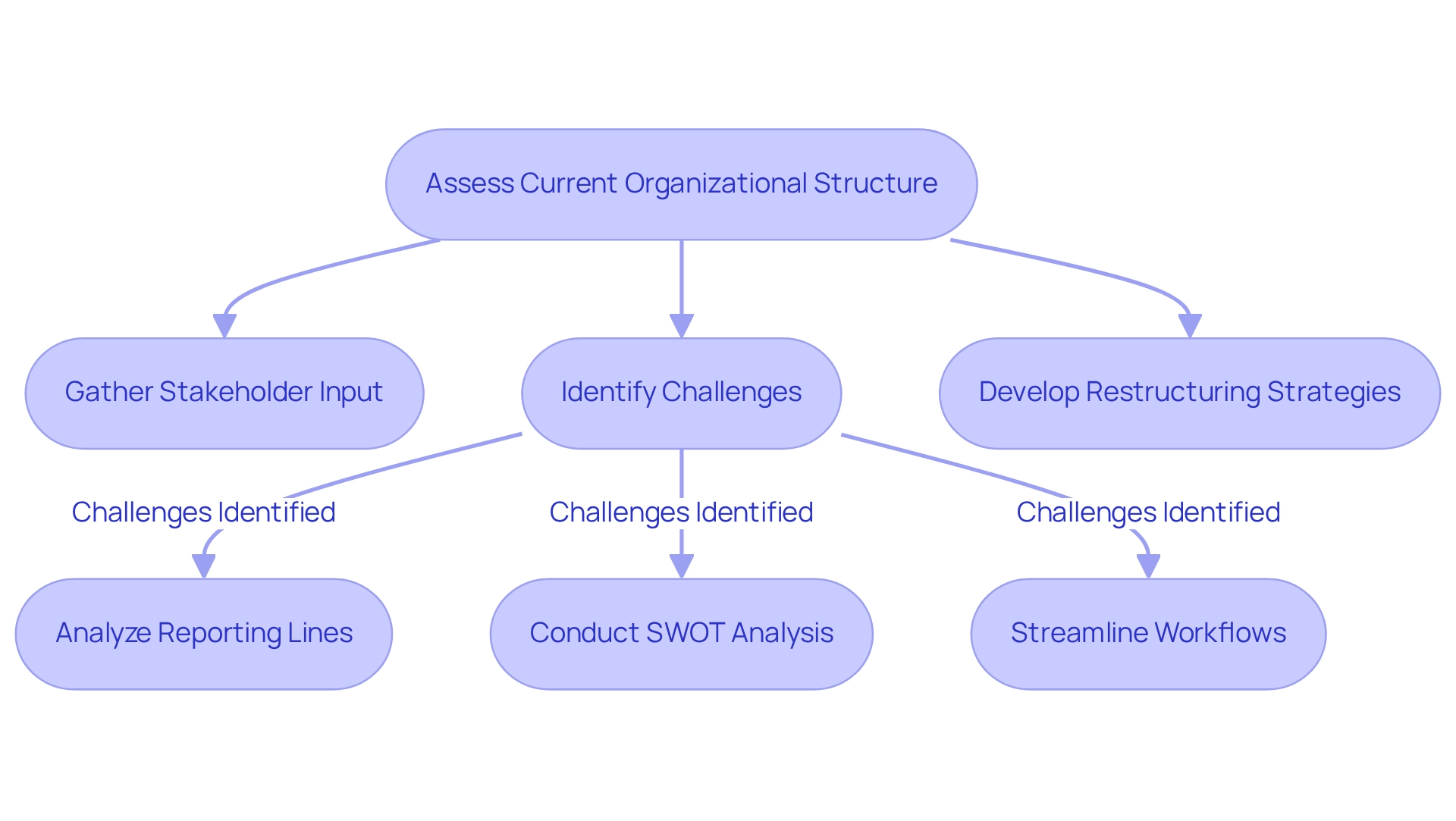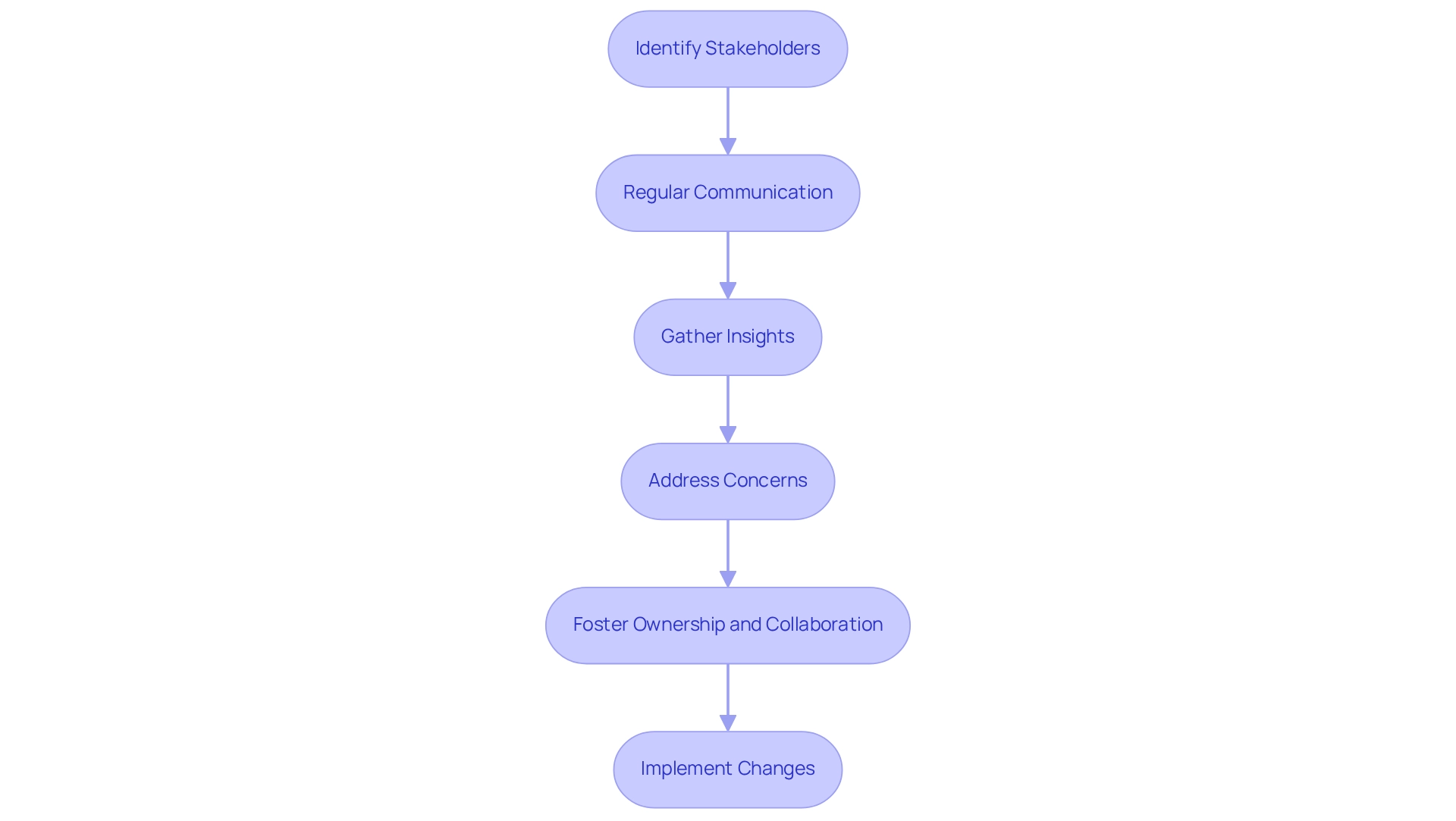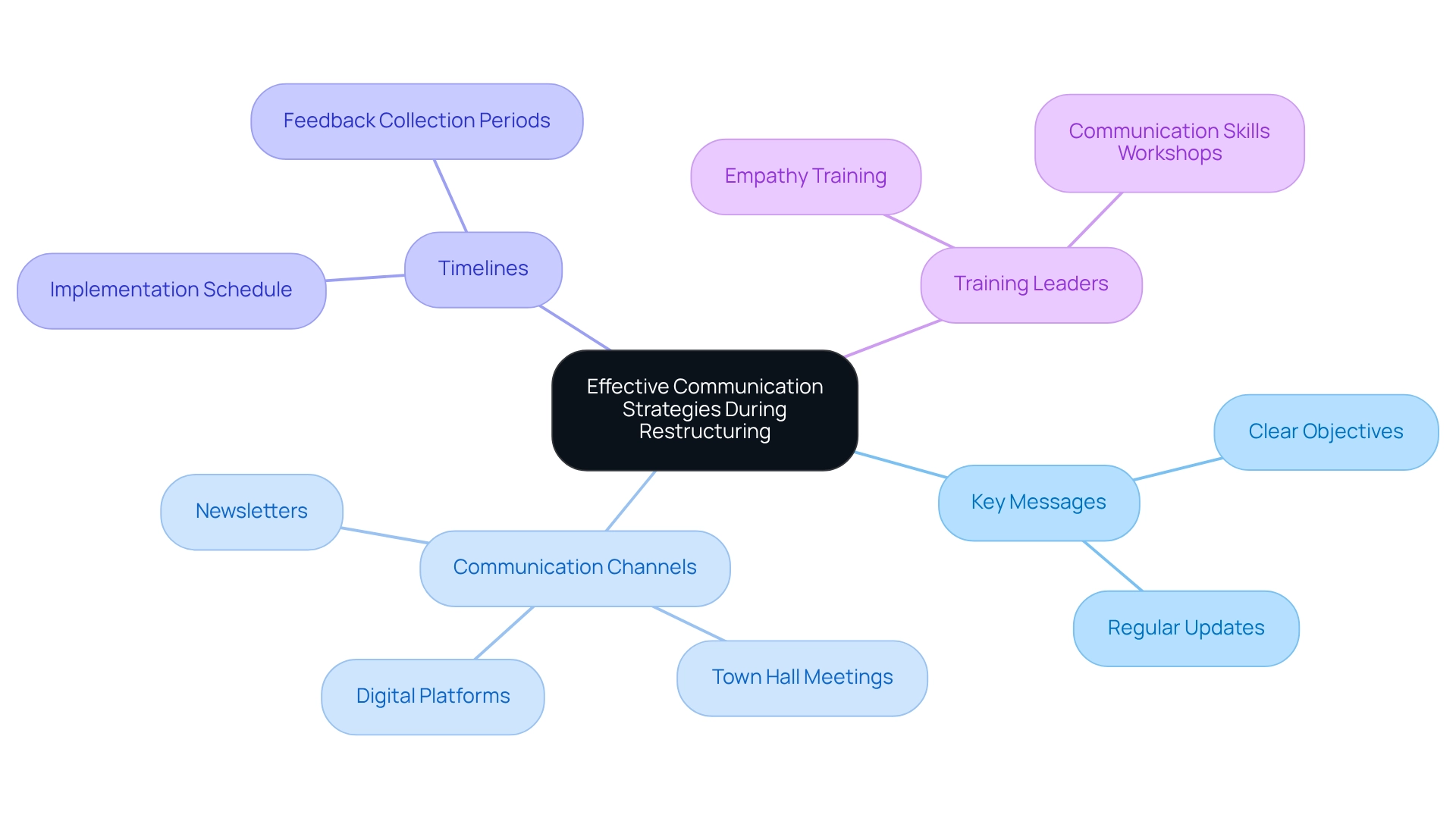Overview
The article delineates four pivotal steps essential for successful corporate restructuring:
- Defining clear objectives
- Assessing the current organizational structure
- Engaging stakeholders
- Implementing effective communication strategies
These steps are imperative as they empower organizations to streamline operations, foster collaboration, and uphold transparency. Consequently, this approach significantly enhances the likelihood of a successful restructuring process.
Introduction
In the dynamic landscape of corporate restructuring, success hinges on a multifaceted approach that begins with clear objectives and extends through effective stakeholder engagement and communication. Organizations must navigate the complexities of change by first defining their goals, which can range from enhancing operational efficiency to improving cash flow.
As they embark on this journey, a thorough assessment of the current organizational structure becomes essential, allowing businesses to pinpoint challenges and streamline processes. Engaging stakeholders throughout the restructuring process fosters collaboration and minimizes disruption.
Moreover, implementing robust communication strategies ensures transparency and builds trust. By examining these critical elements, organizations can not only weather the storm of change but emerge stronger and more resilient in the face of evolving market demands.
Define Clear Objectives for Restructuring Success
The establishment of clear objectives is essential for successful corporate restructuring roadmaps that guide the entire process. These objectives should address both immediate and long-term goals, such as:
- Improving cash flow
- Enhancing operational efficiency
- Positioning for market expansion
For instance, a retail client might aim to reduce operational costs by 20% within the next fiscal year while also striving to boost customer satisfaction scores. By clearly communicating these goals, organizations can create corporate restructuring roadmaps that guide decision-making and prioritize initiatives aligned with their vision, highlighting the importance of well-defined objectives as 74% of staff report feeling overwhelmed by rapid transformations.
This reveals the necessity for clarity in goals to foster a focused and motivated workforce, as clear objectives can mitigate feelings of overwhelm and guide employees through transitions. Consistently revisiting and adjusting these objectives during the corporate restructuring roadmaps is essential for sustaining flexibility in response to changing conditions, and expert insights further support this strategy.
Camille Soulier, a recognized authority in corporate strategy, emphasizes that aligning team efforts with measurable outcomes is essential for cohesive progress. Moreover, case studies, such as Chad Martin's experience at MeridianLink, demonstrate the importance of inclusive leadership in setting goals, where considering diverse viewpoints can lead to more thorough and effective corporate restructuring roadmaps.
Additionally, insights from Cathie Lesjak highlight the significance of performing detailed financial evaluations to uncover opportunities for cash preservation and liability reduction, which can greatly enhance the future worth of the business and align with the financial goals of reorganization.
By prioritizing clear objectives and concentrating on thorough financial assessments, including interim management and bankruptcy case management services, businesses can significantly improve their chances of successful reorganization, particularly in dynamic sectors like retail and hospitality. Incorporating a focus on in-house development, as noted by Luca Maestri, can also provide better control over innovation during the organizational change process, further supporting operational efficiency.
Assess Current Organizational Structure and Identify Challenges
A comprehensive evaluation of the current organizational framework is essential during the reorganization process to inform the development of corporate restructuring roadmaps. This involves analyzing reporting lines, departmental functions, and employee roles. Actively gathering input from various stakeholders is crucial to gain insights into existing challenges. By pinpointing challenges such as unclear roles and communication breakdowns, organizations can develop corporate restructuring roadmaps that lead to targeted strategies. Identifying these challenges enables organizations to eliminate redundancies, streamline workflows, and foster collaboration. Our team will identify underlying business issues and work collaboratively to create a plan that mitigates weaknesses, enabling the business to reinvest in key strengths. Tools like organizational charts and performance metrics are invaluable in this assessment, offering a clear view of the current state and informing future improvements. Moreover, techniques like SWOT analysis and stakeholder interviews can enhance the evaluation process.
Data show that efficient organizational assessments can significantly lower high production expenses by pinpointing inefficiencies and streamlining resource distribution. This highlights the importance of this process for small enterprises facing changes in 2025. Regular evaluations and responsiveness to feedback are essential for maintaining alignment with strategic goals, as highlighted by industry experts. Furthermore, we are pragmatic in our approach to data; we test every hypothesis to deliver maximum return on invested capital in both the short and long term. Promoting modern HR skills through online courses can equip teams with the necessary tools to effectively manage organizational assessments, leading to more effective crisis management and sustainable growth.

Engage Stakeholders in the Restructuring Process
Engaging stakeholders is essential for the development of effective corporate restructuring roadmaps. Organizations must first identify key individuals and groups affected by the changes, including employees, management, suppliers, and customers. Regular communication through meetings, surveys, and feedback sessions is vital for gathering insights and addressing concerns. For instance, a restaurant chain undergoing reorganization could hold focus groups with employees to discuss suggested changes and seek feedback on operational improvements. This proactive involvement fosters a sense of ownership and collaboration among stakeholders, which is crucial for minimizing disruption and ensuring a smooth transition.
Studies show that entities that emphasize stakeholder involvement during restructuring experience notably greater success rates, as employees who feel included are more inclined to back the changes. Moreover, effective communication strategies not only sustain trust but also boost the overall morale of the workforce, ultimately contributing to a more resilient establishment. Stakeholders appreciate being informed about the exit process and its implications, reinforcing the need for transparency. As Jack Welch advises, entities should 'change before it becomes necessary,' highlighting the importance of proactive engagement.
Additionally, considering employee wages and job security during rehabilitation or liquidation is critical, as it reflects ethical considerations that impact morale. By starting with a thorough business evaluation to align key stakeholders and identify underlying issues, entities can create corporate restructuring roadmaps that not only address these challenges but also enhance their assets. A case study on 'Engaging with Stakeholders - Exit Strategies' demonstrates that by recognizing stakeholders, creating a plan for information sharing, and being open about the exit process, entities can preserve trust and support during the transition.

Implement Effective Communication Strategies During Restructuring
Implementing effective interaction strategies necessitates a meticulously organized plan, which includes corporate restructuring roadmaps that explicitly define key messages, channels, and timelines. As Nitin Nohria, former dean of the Harvard Business School, asserted, "Communication is the real work of leadership," underscoring the pivotal role of communication in steering groups through change.
Prioritizing transparency is imperative; organizations must provide consistent updates regarding the corporate restructuring roadmaps and their implications. For example, leveraging newsletters, town hall meetings, and digital platforms can enhance information sharing and facilitate feedback collection.
Training leaders to communicate with empathy is essential, as it empowers them to address employee concerns and bolster the commitment to supporting staff during the transition. Notably, studies reveal that 50% of leaders are uncertain about the success of recent organizational changes, highlighting the critical need for clear messaging strategies to alleviate this uncertainty.
By fostering transparent exchanges, organizations can build trust and ensure that all stakeholders feel valued and informed throughout the corporate restructuring roadmaps. Furthermore, Gallup's findings emphasize the significance of regular, meaningful discussions between managers and staff, which can enhance engagement and clarify expectations. This approach not only fortifies relationships but also contributes to a more resilient organizational culture during periods of change.
As Plato remarked, effective communication should be purposeful and thoughtful, rather than merely frequent, thereby emphasizing the necessity for quality interactions. The case study titled "The Role of Meaningful Conversations" exemplifies this notion, demonstrating that regular, strengths-based discussions can markedly improve employee relationships and engagement, making it crucial for managers to prioritize these interactions.

Conclusion
In conclusion, successful corporate restructuring hinges on a strategic focus encompassing several critical elements. Organizations that define clear objectives not only navigate the restructuring process purposefully but also align their efforts to enhance operational efficiency and meet financial goals. The significance of establishing measurable targets is paramount; these targets guide decision-making and foster a motivated workforce amidst the inevitable changes.
A comprehensive assessment of the current organizational structure is essential for pinpointing challenges and streamlining processes. By analyzing existing roles and soliciting input from stakeholders, companies can eliminate redundancies and promote collaboration, ultimately leading to enhanced operational efficiency. Furthermore, continuous evaluation and adaptation of strategies based on real-time feedback are vital for maintaining alignment with the overarching goals of the restructure.
Engaging stakeholders throughout the process significantly increases the likelihood of success. Open communication and proactive involvement cultivate a sense of ownership among employees and other affected parties, which is crucial for minimizing disruption. By prioritizing transparency and addressing concerns, organizations can sustain trust and morale during transitions.
Lastly, implementing effective communication strategies is crucial. A well-structured communication plan, characterized by empathy and clarity, ensures that all stakeholders remain informed and engaged. This approach not only strengthens relationships but also fosters a resilient organizational culture capable of navigating change.
Organizations that approach restructuring with clear objectives, thorough assessments, active stakeholder engagement, and robust communication strategies are better positioned to emerge stronger and more resilient in an ever-evolving market landscape. Embracing these foundational elements transcends mere change management; it embodies the essence of thriving amidst transformation.
Frequently Asked Questions
Why are clear objectives important in corporate restructuring?
Clear objectives are essential for successful corporate restructuring as they guide the entire process, addressing both immediate and long-term goals. They help organizations create roadmaps that prioritize initiatives aligned with their vision.
What types of goals should be included in corporate restructuring objectives?
Corporate restructuring objectives should include goals such as improving cash flow, enhancing operational efficiency, and positioning for market expansion.
Can you provide an example of a corporate restructuring goal?
An example would be a retail client aiming to reduce operational costs by 20% within the next fiscal year while also striving to boost customer satisfaction scores.
How do clear objectives affect employee morale during restructuring?
Clear objectives can mitigate feelings of overwhelm among employees, fostering a focused and motivated workforce during transitions.
Why is it important to revisit and adjust objectives during the restructuring process?
Consistently revisiting and adjusting objectives is essential for maintaining flexibility in response to changing conditions, ensuring that the organization remains aligned with its goals.
What role does leadership play in setting restructuring goals?
Inclusive leadership, which considers diverse viewpoints, is important for setting goals that lead to thorough and effective corporate restructuring roadmaps.
How can financial evaluations contribute to successful reorganization?
Detailed financial evaluations can uncover opportunities for cash preservation and liability reduction, enhancing the future worth of the business and aligning with financial goals.
What sectors particularly benefit from prioritizing clear objectives during restructuring?
Dynamic sectors like retail and hospitality can significantly improve their chances of successful reorganization by prioritizing clear objectives and thorough financial assessments.
How can in-house development support operational efficiency during organizational change?
Focusing on in-house development can provide better control over innovation during the organizational change process, further supporting operational efficiency.




